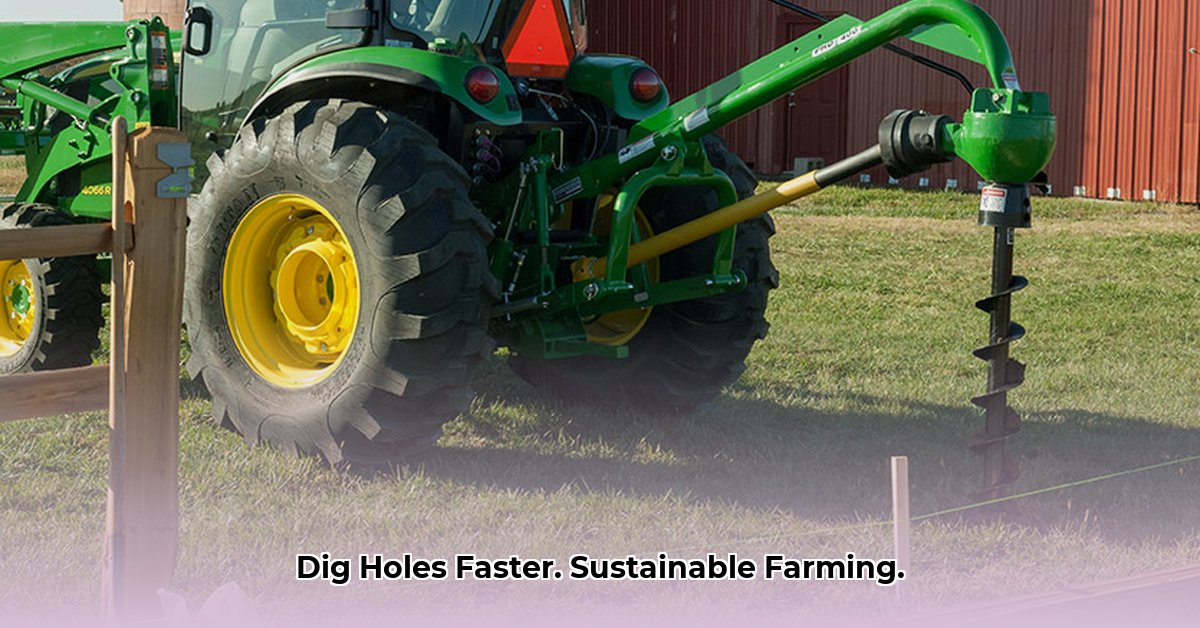
3-Point Post Hole Diggers: Boosting Efficiency and Sustainability
Tired of the backbreaking labor of digging post holes? A tractor-mounted 3-point post hole digger can revolutionize your farming operations, significantly increasing efficiency and promoting sustainable practices. This guide provides a comprehensive overview of selecting, operating, and maintaining these valuable tools. We’ll also explore their role in enhancing your farm’s sustainability and performing a cost-benefit analysis to help you make an informed investment decision. For more information on tractor attachments, check out this helpful resource on tractor aerators.
Choosing the Right 3-Point Post Hole Digger
Selecting the appropriate digger is crucial for optimal performance and longevity. Several factors influence this decision:
Matching Digger to Tractor and Soil Type
Before you begin your search, assess your tractor's horsepower and the characteristics of your soil. A high-horsepower tractor can handle a larger, more robust digger, while lighter models are suitable for smaller tractors. Clay soil, for instance, requires a more powerful digger than sandy soil. Ignoring this crucial compatibility step may lead to equipment damage or inefficiency.
Auger Bit Selection: Balancing Speed and Soil Health
The auger bit size directly impacts digging speed and soil health. Larger bits dig faster but increase soil compaction, potentially harming plant growth and water infiltration. Smaller bits are gentler, promoting better root development and water drainage, though they may require more time. Consider your long-term soil health goals and choose accordingly. A crucial question to ask yourself: "Will the trade-off between speed and soil health benefit my farm in the long run?"
Hydraulic vs. PTO Systems: Efficiency and Ease of Use
Many diggers offer hydraulic systems or those that utilize the tractor's PTO (Power Take-Off). Hydraulic systems generally offer smoother and easier operation and reduce strain on the tractor. PTO systems can be more cost-effective initially but may require more operator skill. Evaluate which system aligns with your needs and operational expertise.
Build Quality and Materials: Investing in Durability
Durability is key to minimizing long-term costs. Look for diggers constructed from heavy-duty steel or other robust materials. Read reviews to gauge the reliability of various models. A well-built digger will withstand the rigors of daily farm work, saving you time and money on repairs in the long run.
Warranty and Manufacturer Support
A comprehensive warranty demonstrates manufacturer confidence. A strong warranty provides vital protection against defects and assures that the necessary support is readily available should you encounter unforeseen issues. It offers reassurance and minimizes your risk.
Operating Your 3-Point Post Hole Digger Safely and Efficiently
Safe and efficient operation is paramount. Follow these steps for every use:
Pre-Operation Inspection: Thoroughly inspect the digger for loose bolts, worn parts, and any other signs of damage. Address any issues before commencing operations. This simple step can prevent significant problems and accidents.
Proper Hitching: Carefully attach the digger to your tractor's three-point hitch, precisely following the manufacturer's instructions. Rushing this step can lead to accidents.
Controlled Lowering: Gently lower the auger into the ground, avoiding sudden movements that could damage the equipment or cause injury.
Smooth Engagement: Carefully engage the PTO or activate the hydraulic system, avoiding sudden starts that can strain the equipment or trigger accidents.
Monitoring Depth: Utilize the digger's depth gauge for consistent hole depth. Precise depth control is especially important for tasks like fence installation, where uniform post placement is crucial.
Careful Raising: When finished, smoothly raise the auger, avoiding rapid or jerky motions that could lead to accidents.
Maintaining Your 3-Point Post Hole Digger for a Long Life
Regular maintenance directly impacts the digger’s longevity and efficiency. This includes:
Lubrication: Maintain proper lubrication of all moving parts, following the manufacturer's recommendations. This minimizes friction and extends the lifespan of your equipment.
Thorough Cleaning: Clean the auger and remove mud or debris after each use to prevent corrosion. A simple cleaning routine can significantly extend your digger’s life.
Regular Inspection: Regularly inspect the auger, bearings, and other components for wear and tear. Replace worn parts promptly to prevent more serious damage. Consider this preventative maintenance crucial to keeping operational costs down.
Proper Storage: Store the digger in a clean, dry location to prevent rust and corrosion. Protection from the elements significantly increases its useful life.
Cost-Benefit Analysis: Justifying the Investment
The initial cost of a 3-point post hole digger may seem significant. However, a thorough cost-benefit analysis quickly reveals its long-term value:
Time Savings: Significantly reduces the time spent digging holes manually, allowing you to complete more tasks in less time.
Labor Cost Reduction: Eliminates the need for manual labor, resulting in substantial cost savings, particularly for large projects.
Enhanced Efficiency: Optimizes your workday, leading to increased productivity and a better return on your time investment.
Consider labor costs, fuel consumption, and the value of your time when comparing the upfront costs with the long-term benefits. The enhanced efficiency often justifies the investment relatively quickly.
Sustainable Farming and Your 3-Point Post Hole Digger
These diggers play a vital role in sustainable farming practices:
Minimized Soil Compaction: Using smaller auger bits reduces compaction, promoting healthier soil structure and enhanced water infiltration. This benefits overall soil health and long-term sustainable productivity.
Reduced Fuel Consumption: Improved efficiency leads to reduced fuel consumption and lowers your carbon footprint.
Comparing Different Brands and Models
[This section would include a comparative table of different brands and models, considering factors such as auger size, horsepower requirements, weight, price, warranty, and ease of maintenance. This data would need to be obtained through further research.]
Conclusion: A Sustainable Investment for Efficient Farming
A 3-point post hole digger is more than just a tool; it's a significant investment in the efficiency and sustainability of your farming operation. By carefully considering factors such as tractor compatibility, auger bit size, and maintenance requirements, farmers can select a digger that optimizes productivity while minimizing environmental impact. The long-term benefits—reduced labor costs, enhanced efficiency, and improved soil health—make it a worthwhile investment for any farmer committed to sustainable agriculture.